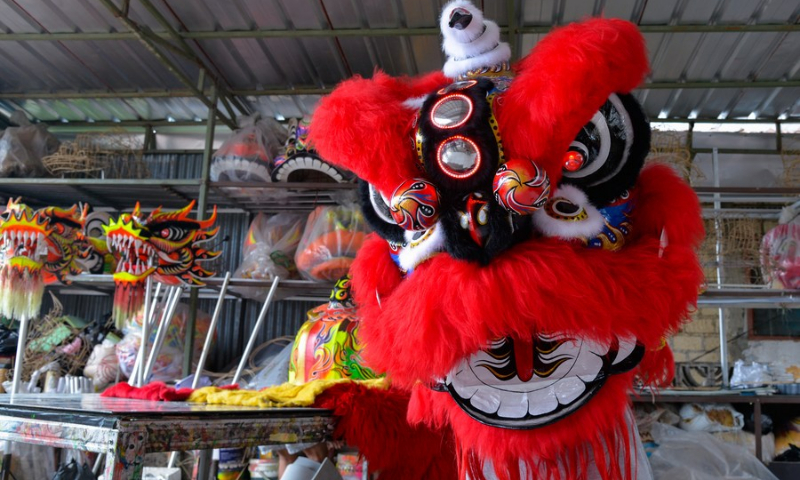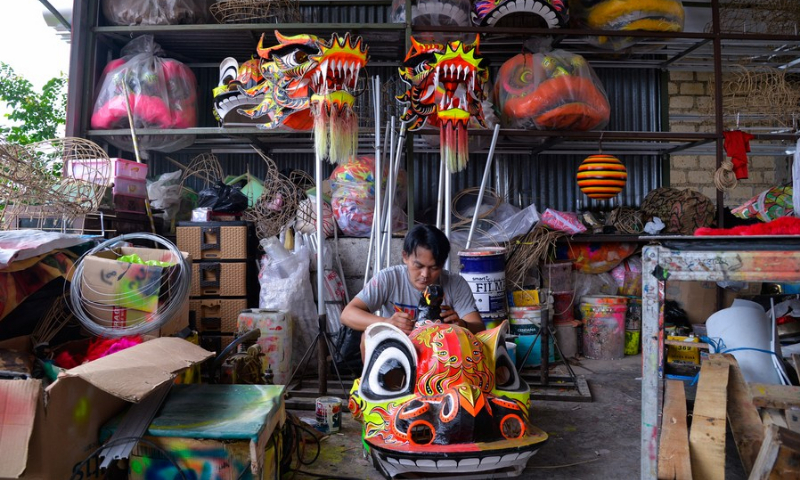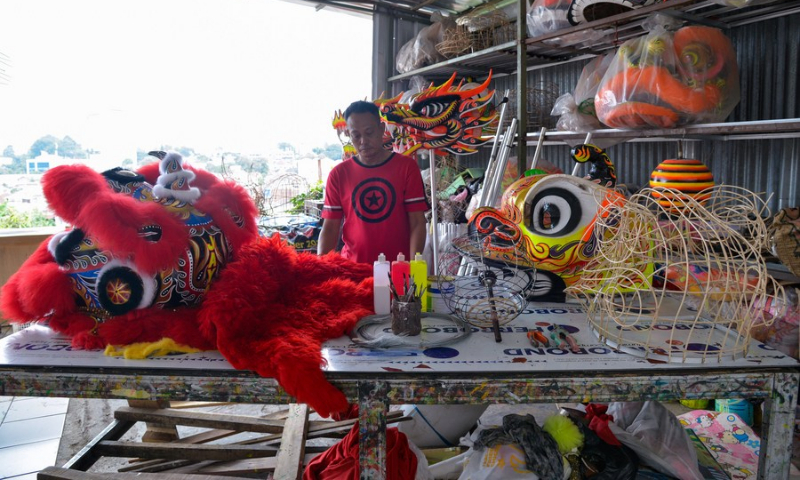
Lily Hambali shows lion dance at his workshop in Bogor, Indonesia on Feb. 14, 2022. (Photo: Xinhua)

Craftsman Herdian colors a lion head for lion dance at Lily Hambali's workshop in Bogor, Indonesia on Feb. 14, 2022. (Photo: Xinhua)

Lily Hambali shows finished and semi-finished products for lion dance at his workshop in Bogor, Indonesia on Feb. 14, 2022. (Photo: Xinhua)
In Bogor, about 50 km south of the Indonesian capital Jakarta, Lily Hambali's workshop makes traditional costumes for the Chinese lion dance, locally known as barongsai. His dancing lions can be seen all around Indonesia, and even overseas.
Craftsmen at the Lily Barongsai & Liong are hard at work, while several finished barongsai costumes lurk by the walls, ready for shipment. The days before Cap Go Meh, the first full moon of the new lunar year, or Lantern Festival in China, are the workshop's busiest of the year. Hambali's four staff make a good living from the Chinese tradition.
"I was just a barongsai dancer more than 20 years ago. When there was damage to our costumes, we just fixed it by ourselves. I was good at it and I became a barongsai maker," Hambali told Xinhua.
A lot of the materials, nearly 70 percent, are hard to find in Indonesia. Sheepskin and rabbit pelts for making the lion's mane are imported from Guangzhou and Wuhan in China. The frames are made of rattan. These are the crucial parts of the lion and are fashioned with great precision.
"After we attach the fabric and paper, we paint them. Then we add the mane and some distinctive accessories," said Hambali.
It takes about a week to complete one costume, which can cost as much as 8 million rupiahs (about 560 U.S. dollars). This year, orders have come exclusively from within the archipelago. Demand at home means there is no need to look overseas. Orders for Cap Go Meh have been coming in since October 2021.
Before the pandemic, Hambali received up to 80 orders for Chinese New Year, and had to ask his neighbors for help. "With restrictions on gatherings, we stopped taking orders in January (this year), as we had already accepted more than enough. We have almost finished the 20 orders we took this year," he said.
Indonesians of Chinese descent enjoy the lion dance as a traditional part of their transplanted culture, while others are drawn to the spectacle of noise, flamboyant costumes and daring acrobatic feats. Over the years, the barongsai has become a fusion of Chinese costumes and movements, accompanied by Indonesian folk songs.
Hambali's own barongsai group performs in malls or hotels throughout the Chinese New Year season. At Cap Go Meh, they join parades in Jakarta and Bogor. They often perform at weddings and other celebrations, or take part in competitions. They have even taken part in a traditional Islamic New Year parade.
For Hambali, the barongsai is not just a way to make a living, but a way of life. He teaches students both the dance itself and passes on his skills as a costume designer. The lion dance, he says, has made him a lot of friends.
"I can see a promising future as both a craftsman and a dancer. I would love to see original Chinese performances and maybe to compete with Chinese dancers on the international stage," he said.
